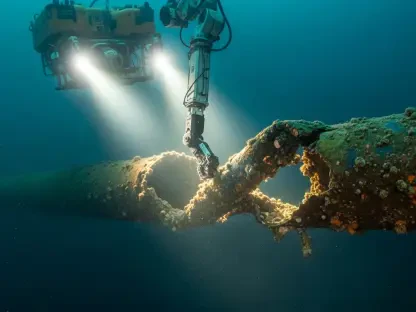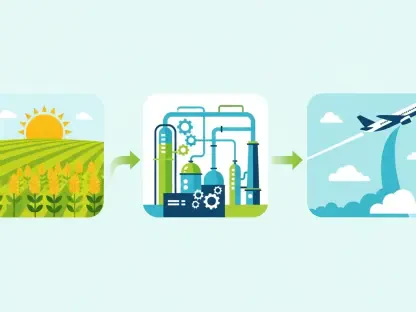Imagine a modest investment in a declining industry turning into a potential goldmine worth billions, reshaping national security and global technology markets in one fell swoop. This is the extraordinary situation surrounding a Wyoming coal mine purchased for just $1.9 million by Randall Atkins, a former banker turned entrepreneur, through his company, Ramaco Resources. What began as a routine acquisition of a coal operation has transformed into a staggering discovery of rare earth metals—elements like neodymium, dysprosium, and terbium—potentially valued at over $33 billion. These metals are indispensable for modern innovations, from electric vehicles to defense systems, making this find a possible game-changer for the United States. Beyond the jaw-dropping financial implications, this unexpected windfall raises critical questions about resource independence, environmental challenges, and the future of American industry in a tech-driven world.
Unearthing a Hidden Treasure
The story of this Wyoming mine is nothing short of remarkable, as a site initially pegged for coal extraction revealed an untapped wealth of rare earth metals, critical to high-tech and green energy sectors. Purchased with the intent of continuing traditional mining operations, the property stunned its owners when geological assessments uncovered vast deposits of elements essential for manufacturing everything from wind turbines to advanced electronics. This marks the first significant discovery of such resources on American soil in over seven decades, positioning Ramaco Resources at the forefront of a potential industrial revolution. The sheer scale of the estimated value—over $33 billion—underscores the transformative nature of this find, shifting focus from a fading fossil fuel industry to a cutting-edge resource market. For a nation heavily reliant on foreign imports for these materials, the implications are profound, hinting at a rare opportunity to redefine domestic production capabilities in a strategic sector.
Equally striking is the historical context of this discovery, as it aligns with a pivotal moment when global demand for rare earth metals is soaring amid the push for sustainable energy solutions. These elements, while not scarce in nature, are notoriously difficult and costly to extract and refine, often leaving countries vulnerable to supply chain disruptions. The Wyoming deposit offers a chance to pivot away from dependency on foreign sources, particularly from regions that dominate the market. This find could serve as a catalyst for revitalizing a local economy long tied to coal, breathing new life into a community through jobs and investment in modern mining technologies. However, the excitement surrounding this discovery must be tempered with an understanding of the complex road ahead, as turning raw potential into tangible output requires overcoming significant logistical and regulatory barriers that have historically plagued the industry.
Strategic Implications for National Security and Industry
The discovery of rare earth metals in Wyoming carries immense strategic weight, especially given the United States’ current dependence on imports for nearly all of its supply, with a single country controlling almost 90% of the global market. These materials are the backbone of critical industries, powering components in defense systems, renewable energy infrastructure, and consumer electronics that define modern life. Securing a domestic source could drastically reduce vulnerabilities tied to geopolitical tensions and trade uncertainties, bolstering national security at a time when technological superiority is paramount. For policymakers and industry leaders, this find represents a unique window to establish a self-reliant supply chain, potentially altering the balance of power in global resource dynamics. The stakes are high, as success in harnessing these deposits could position the nation as a leader in a market poised for exponential growth over the coming decades.
Beyond security, the industrial ramifications of this discovery ripple across multiple sectors, promising to fuel innovation in clean energy and advanced manufacturing right on American soil. Electric vehicle production, wind energy expansion, and military technology development stand to benefit immensely from a stable, local supply of rare earths, cutting costs and delivery times associated with overseas sourcing. This could accelerate the transition to greener technologies, aligning with national goals for sustainability while fostering economic growth in regions hit hard by the decline of traditional industries like coal. Yet, enthusiasm must be balanced with caution, as the process of bringing these resources to market involves navigating a maze of federal regulations, securing substantial capital investment, and addressing public concerns over mining’s impact. The challenge lies in transforming this raw potential into a functioning, competitive industry without compromising long-term strategic or environmental priorities.
Challenges on the Path to Production
Turning a geological discovery into a viable operation is a daunting task, fraught with technical, financial, and environmental hurdles that could derail even the most promising ventures. Extracting rare earth metals is a complex endeavor, requiring specialized equipment and processes that differ vastly from conventional coal mining, often involving the use of hazardous chemicals that pose risks to ecosystems and communities. Ramaco Resources must develop innovative methods to minimize harm while meeting stringent regulatory standards, a balancing act that demands significant expertise and funding. Past attempts to establish similar operations in the United States have stumbled due to high costs and public opposition, casting a shadow over the feasibility of this project. The path forward will test the company’s ability to adapt and collaborate with stakeholders to ensure responsible development in an industry under intense scrutiny.
Moreover, the environmental implications of mining rare earths cannot be overstated, as the process generates toxic waste that, if mishandled, could devastate local landscapes and water supplies, sparking fierce debate among activists and policymakers. Addressing these concerns requires not only cutting-edge technology but also transparent communication with the public to build trust and secure social license to operate. Additionally, the financial scale of such a venture is staggering, with billions potentially needed to move from exploration to full-scale production over the next several years, starting now through projected timelines. Attracting investors willing to shoulder the risk, alongside gaining government support through incentives or streamlined permitting, will be critical to overcoming these barriers. While the promise of a $33 billion payoff is enticing, the reality of achieving it hinges on meticulous planning and execution in an arena where failure is a frequent outcome.
Reflecting on a Historic Opportunity
Looking back, the uncovering of rare earth metals in a Wyoming coal mine stood as a defining moment that captured the imagination of industry experts and policymakers alike. It highlighted the unpredictable nature of resource exploration, where a modest investment morphed into a potential cornerstone for technological and economic advancement. The journey of Randall Atkins and Ramaco Resources underscored the importance of adaptability in a rapidly changing industrial landscape, where old sectors could find new purpose. Moving forward, the focus must shift to actionable strategies—investing in sustainable mining technologies, fostering public-private partnerships, and prioritizing environmental stewardship. This historic find challenged the nation to rethink its approach to resource independence, urging a collective effort to turn raw potential into lasting impact. The next steps involve rigorous planning and innovation to ensure that such an extraordinary opportunity reshapes global markets for the better.









